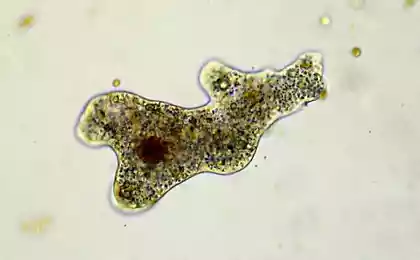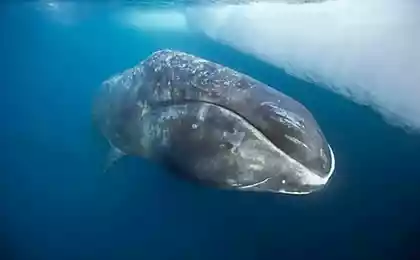248
Long-lived animals that can outlive humans
Most people in developed countries can live an average of 70-80 years or more. Human life expectancy is growing thanks to the help of modern medicine and the availability of quality food and hygiene. The oldest person in history is a French woman who lived 122 years. Needless to say, human lifespans are much longer than most of our four-legged friends: most dogs and cats rarely live more than 2 decades, and many other pets have even shorter lifespans. But there are some animals in the wild that can live longer than humans, sometimes even twice their maximum lifespan. For example, certain species of turtles easily reach their 250th birthday, and some whales can live 100 years. If you want a long-lived pet, then you can pay attention to the ara, as they often outlive their owners. There is even one animal that is considered clinically immortal: a certain type of jellyfish that can actually return to a younger state. In this film, you will learn about some long-lived animals that can outlive humans.
Native to Central America, Mexico, South America and the Caribbean, the colorful and spectacular maca parrot can live for about 100 years. The oldest macaw recorded is a blue and yellow parrot named Charlie, who lived for 111 years. Like humans, the average lifespan of most blue and gold ars is approximately 60-80 years. They are very friendly and sociable. In the wilderness, they live in groups, but in captivity they get closer to people and become a full-fledged member of the family. Since their lifespan is so long and they can easily outlive a human, the owner of such a bird should write their favorite pet in the will to be taken care of in the event of the death of the owner.
Orcas inhabit most oceans, from the Arctic and Antarctic to tropical waters. In indigenous Pacific Northwest cultures, they are traditionally considered the strongest animals in the ocean. Orcas are at the top of the food chain. These large creatures are very social – each group has its own complex “culture” that influences killer whale behavior, hunting, and socialization. No wonder these animals are very intelligent. In the wild, killer whales usually live about 50 years. However, some females can live 80-90 years, and the oldest recorded killer whale was about 101 years old.
Do not be surprised that your lobster lunch can be around 100 years old. Some lobsters caught in the ocean were over 60 years old. These creatures continue to grow throughout their lives, molting as needed to ensure further growth (the largest lobster ever caught weighed more than 20 kilograms). Age has no effect on their survivability - the study found that older lobsters are actually more fertile than younger lobsters. In 2009, a lobster over 140 years old was caught.
This deep-sea ocean fish lives in the cool waters of the Pacific Ocean and is known for its long lifespan. It is said that the Orange Bighead can live up to 150 years or more, although it grows very slowly, reaching maturity in 20-40 years. This makes them quite vulnerable because fish are often caught before they have a chance to reproduce. Commercial fishing, including deep-sea trawling techniques, is also destroying their habitat, causing population declines. That prompted some grocery chains to ban the sale of Atlantic sawfish to preserve the species.
Gatteria is a reptile that lives only in New Zealand. Once their population was almost wiped out due to the influx of rats into their habitat. Fortunately, these little lizard-like creatures have been able to re-emerge and are now thriving. Gatteria, or tuatara, is similar to a medium-sized lizard, but is actually a unique creature belonging to a very different species. The reason the tuatara is in danger is because it takes a very long time to reproduce. They become mature only in old age. One in New Zealand living in captivity first reproduced by the age of 111. Although the average lifespan of the gutter is 60 years, some individuals live up to 200 years.
Elegant Koi carp are often taken as pets in garden ponds and live about 100 years. But there have also been recorded individuals living for 200 years. Carp Koi begins life as a very small fish, but can eventually grow to a meter long. It is a very hardy fish, especially as it gets older and bigger. If you feed the fish and take good care of it, it will easily live for more than a hundred years, outliving its owners. One legendary Koi is said to have celebrated his 225th birthday.
Giant Turtles are not very fast, but their slowness and stability allows you to win races in terms of life expectancy. Turtles have a very long lifespan - they can outlive humans twice, or even three times. The oldest recorded specimen is the Aldabra Giant Tortoise, which lived for 250 years. The Seychelles still has a turtle that is 182 years old. No matter what part of the world they inhabit, most turtles have a significant lifespan of around 200 years.
The Greenland or polar whale will outlive any other mammal on Earth, including humans. This very large creature can weigh up to 100 tons. His home is located in Arctic and subarctic waters off Greenland, Alaska, Canada and Russia. Its large, rock-hard head can pierce Arctic ice, allowing it to breathe in cold waters. Although most other whale species do live a very long life (60-70 years), the polar bowhead whale lives 150-200 years. In 2007, a whale caught off the coast of Alaska was extracted from its neck harpoons produced in 1890.
Ciprina Icelandic Mollusks have an incredibly long life expectancy. They are among the oldest creatures in the animal world. But among them stands out one type of mollusk, Ciprina Icelandic (Arctica Islandica), which has lived in the North Atlantic Ocean for hundreds of years. Similar mollusks were found about 500 years old. One was discovered off the coast of Iceland in 2006. And although the mollusk eventually died in captivity, it would surely have lived longer in its natural environment. Arctica Islandica is also eaten and is a popular seafood. So, the next time you order clams in a restaurant, they may be several hundred years old. Many other types of mollusks also live to old age. For example, mussels that produce freshwater pearls can live for about 200-250 years.
This jellyfish (Turritopsis nutricula) not only has a longer lifespan than humans, it is considered “immortal.” This small type of jellyfish lives in the Mediterranean Sea and in waters near Japan. Its key to immortality is that the jellyfish can return to the stage of its life before puberty. When jellyfish mature, they create a colony of polyps (which are genetically identical). After that, she is considered sexually mature. However, if life conditions change, or the jellyfish begins to age, it will simply return to the polyp stage and form a new colony. In essence, it changes the state of its cells and transforms them into new types of cells. And while there are natural predators and enemies that often shorten its lifespan, jellyfish have the potential to live forever.
Source: lifeglobe.net/
Native to Central America, Mexico, South America and the Caribbean, the colorful and spectacular maca parrot can live for about 100 years. The oldest macaw recorded is a blue and yellow parrot named Charlie, who lived for 111 years. Like humans, the average lifespan of most blue and gold ars is approximately 60-80 years. They are very friendly and sociable. In the wilderness, they live in groups, but in captivity they get closer to people and become a full-fledged member of the family. Since their lifespan is so long and they can easily outlive a human, the owner of such a bird should write their favorite pet in the will to be taken care of in the event of the death of the owner.
Orcas inhabit most oceans, from the Arctic and Antarctic to tropical waters. In indigenous Pacific Northwest cultures, they are traditionally considered the strongest animals in the ocean. Orcas are at the top of the food chain. These large creatures are very social – each group has its own complex “culture” that influences killer whale behavior, hunting, and socialization. No wonder these animals are very intelligent. In the wild, killer whales usually live about 50 years. However, some females can live 80-90 years, and the oldest recorded killer whale was about 101 years old.
Do not be surprised that your lobster lunch can be around 100 years old. Some lobsters caught in the ocean were over 60 years old. These creatures continue to grow throughout their lives, molting as needed to ensure further growth (the largest lobster ever caught weighed more than 20 kilograms). Age has no effect on their survivability - the study found that older lobsters are actually more fertile than younger lobsters. In 2009, a lobster over 140 years old was caught.
This deep-sea ocean fish lives in the cool waters of the Pacific Ocean and is known for its long lifespan. It is said that the Orange Bighead can live up to 150 years or more, although it grows very slowly, reaching maturity in 20-40 years. This makes them quite vulnerable because fish are often caught before they have a chance to reproduce. Commercial fishing, including deep-sea trawling techniques, is also destroying their habitat, causing population declines. That prompted some grocery chains to ban the sale of Atlantic sawfish to preserve the species.
Gatteria is a reptile that lives only in New Zealand. Once their population was almost wiped out due to the influx of rats into their habitat. Fortunately, these little lizard-like creatures have been able to re-emerge and are now thriving. Gatteria, or tuatara, is similar to a medium-sized lizard, but is actually a unique creature belonging to a very different species. The reason the tuatara is in danger is because it takes a very long time to reproduce. They become mature only in old age. One in New Zealand living in captivity first reproduced by the age of 111. Although the average lifespan of the gutter is 60 years, some individuals live up to 200 years.
Elegant Koi carp are often taken as pets in garden ponds and live about 100 years. But there have also been recorded individuals living for 200 years. Carp Koi begins life as a very small fish, but can eventually grow to a meter long. It is a very hardy fish, especially as it gets older and bigger. If you feed the fish and take good care of it, it will easily live for more than a hundred years, outliving its owners. One legendary Koi is said to have celebrated his 225th birthday.
Giant Turtles are not very fast, but their slowness and stability allows you to win races in terms of life expectancy. Turtles have a very long lifespan - they can outlive humans twice, or even three times. The oldest recorded specimen is the Aldabra Giant Tortoise, which lived for 250 years. The Seychelles still has a turtle that is 182 years old. No matter what part of the world they inhabit, most turtles have a significant lifespan of around 200 years.
The Greenland or polar whale will outlive any other mammal on Earth, including humans. This very large creature can weigh up to 100 tons. His home is located in Arctic and subarctic waters off Greenland, Alaska, Canada and Russia. Its large, rock-hard head can pierce Arctic ice, allowing it to breathe in cold waters. Although most other whale species do live a very long life (60-70 years), the polar bowhead whale lives 150-200 years. In 2007, a whale caught off the coast of Alaska was extracted from its neck harpoons produced in 1890.
Ciprina Icelandic Mollusks have an incredibly long life expectancy. They are among the oldest creatures in the animal world. But among them stands out one type of mollusk, Ciprina Icelandic (Arctica Islandica), which has lived in the North Atlantic Ocean for hundreds of years. Similar mollusks were found about 500 years old. One was discovered off the coast of Iceland in 2006. And although the mollusk eventually died in captivity, it would surely have lived longer in its natural environment. Arctica Islandica is also eaten and is a popular seafood. So, the next time you order clams in a restaurant, they may be several hundred years old. Many other types of mollusks also live to old age. For example, mussels that produce freshwater pearls can live for about 200-250 years.
This jellyfish (Turritopsis nutricula) not only has a longer lifespan than humans, it is considered “immortal.” This small type of jellyfish lives in the Mediterranean Sea and in waters near Japan. Its key to immortality is that the jellyfish can return to the stage of its life before puberty. When jellyfish mature, they create a colony of polyps (which are genetically identical). After that, she is considered sexually mature. However, if life conditions change, or the jellyfish begins to age, it will simply return to the polyp stage and form a new colony. In essence, it changes the state of its cells and transforms them into new types of cells. And while there are natural predators and enemies that often shorten its lifespan, jellyfish have the potential to live forever.
Source: lifeglobe.net/
How to maintain self-esteem in social networks
How to travel the world almost for free and with comfort























